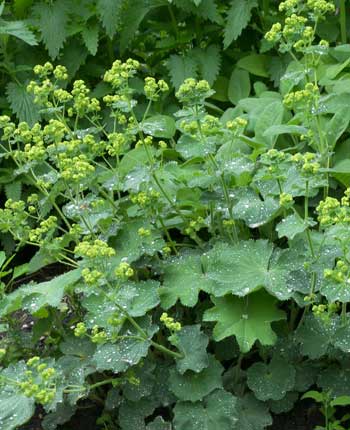Contents:
Common Names | Parts Usually Used | Plant(s) & Culture | Where Found | Medicinal Properties | Biochemical Information
Legends, Myths and Stories | Uses | Formulas or Dosages | Warning | Bibliography
Scientific Names

- Alchemilla vulgaris L.
- Rosaceae
- Rose family
Common Names
- Frauenmantel (German)
Parts Usually Used
Aerial portions
Back to Top

Description of Plant(s) and Culture
Lady’s mantle is a perennial plant; the stem, 4-18 inches high, is at first green or blue-green, turning later to reddish or brownish, and it may be hairy or glabrous, depending on the location. The most basal, rounded leaves are palmately 7 too 9 lobed and finely toothed. The small, green flowers grow in loose panicles from May to October.
Another variety: Silvery lady’s mantle (A. alpina) is a species found at higher elevations, can be used like lady’s mantle and also for flatulence problems. Make a decoction by boiling 1 tbsp. fresh or dried herb in 1 cup water for 5 minutes. Take 1 cup per day.
Back to Top
Where Found
Found in damp places and dry, shady woods in eastern North America, Greenland, Europe, and northern Asia.
Back to Top
Medicinal Properties
Astringent, febrifuge, tonic.
Back to Top
Biochemical Information
Tannin, glycoside, traces of salicylic acid and unidentified substances.
Back to Top
Legends, Myths and Stories
Reminiscent of the Virgin’s cloak in medieval paintings, the leaves with scalloped edges are reputed to give lady’s mantle its name. Like many herbs with “lady” or “mother” as part of their common name, it is a valuable gynecological herb, specifically for heavy menstrual bleeding and vaginal itching. Also, it was one of the most popular wound herbs on the battlefields of the 15th and 16th centuries.
Women in Arabian countries believe that this herb restores beauty and youth; needless to say, it is very popular in that part of the world.
The botanical name, alchemilla, is derived from the word alchemy, because the herbs in this family are believed to bring about miraculous cures.
Back to Top
Uses
Lady’s mantle is taken internally for lack of appetite, rheumatism, stomach ailments, diarrhea, enteritis, PMS, and menstrual problems. It also tends to coagulate blood and is useful for internal or external bleeding, sore throat, and as a mouth rinse after having teeth pulled. Externally, lady’s mantle makes a good douche for leucorrhea, and a wash or poultice for wounds.
Back to Top
Formulas or Dosages
Gather the plant after the dew has dried, from June to August.
Pick plants only where they are clean and never from the wayside or near an alpine dairy.
Infusion: steep 4 tsp. dried herb or leaves in 1 cup water for 10 minutes. Take 1 to 1 1/2 cups per day. For external uses, double the amount of herb or leaves.
Tea: use 1 tbsp. of dried herb in hot water; strain. Drink 1 cup daily.
Extract: for external use; dissolve 5 to 10 drops in 16 oz. of water and use as a douche. It can be applied to wounds.
Back to Top
Warning
Avoid this herb during pregnancy. Seek professional advice for any sudden or abnormal change in uterine bleeding.
Back to Top
Bibliography
![]() Back to Eden
Back to Eden, by Jethro Kloss; Back to Eden Publishing Co., Loma Linda, CA 92354, Original copyright 1939, revised edition 1994
![]() The Herb Book
The Herb Book, by John Lust, Bantam Books, 666 Fifth Avenue, New York, NY. copyright 1974.
![]() The Complete Medicinal Herbal
The Complete Medicinal Herbal, by Penelope Ody, Dorling Kindersley, Inc, 232 Madison Avenue, New York, NY 10016, First American Edition, copyright 1993
![]() Culpeper’s Complete Herbal & English Physician: Updated With 117 Modern Herbs
Culpeper’s Complete Herbal & English Physician: Updated With 117 Modern Herbs, by Nicholas Culpeper, Meyerbooks, publisher, PO Box 427, Glenwood, Illinois 60425, 1990, (reprint of 1814)
 Earl Mindell’s Herb Bible
Earl Mindell’s Herb Bible, by Earl Mindell, R.Ph., Ph.D., Simon & Schuster/Fireside, Rockefeller Center 1230 Avenue of the Americas, New York, New York 10020
![]() The Nature Doctor: A Manual of Traditional and Complementary Medicine
The Nature Doctor: A Manual of Traditional and Complementary Medicine, by Dr. H.C.A. Vogel; Keats Publishing, Inc., 27 Pine Street (Box 876) New Canaan, CT. 06840-0876. Copyright Verlag A. Vogel, Teufen (AR) Switzerland 1952, 1991
Herbal Gardening, compiled by The Robison York State Herb Garden, Cornell Plantations, Matthaei Botanical Gardens of the University of Michigan, University of California Botanical Garden, Berkeley., Pantheon Books, Knopf Publishing Group, New York, 1994, first edition
![]() Planetary Herbology
Planetary Herbology, by Michael Tierra, C.A., N.D., O.M.D., Lotus Press, PO Box 325, Twin Lakes. WI 53181., Copyright 1988, published 1992
 An Instant Guide to Medicinal Plants
An Instant Guide to Medicinal Plants, by Pamela Forey and Ruth Lindsay, Crescent Books (January 27, 1992).
![]() Country Home Book of Herbs
Country Home Book of Herbs, Meredith Books, Editorial Dept. RW240, 1716 Locust Street, Des Moines, IA 50309-3023, copyright 1994
